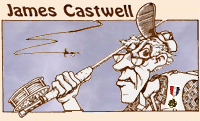|
By now I am sure you have been on the water
and had a 'blanket-hatch.' When there were so
many bugs that your fly didn't have a chance.
Your fly just happens to be a perfect imitation
of the bugs too. Too bad. Forty-nine insects per
square foot and now you think by 'presentation'
your fly has a chance. Not likely. Give it up. I
know, easy for me to say, I keep casting most
often then too, hoping against hope that I will
get lucky. The really smart guys don't do it like
that though you know. They switch to a fly that
will stand out against the crowd. Almost anything
can do it. Bigger. Different color. Just something
which does not look like what they are eating right
then. About the only real chance you have to hook up.
So many of us take great pains to get our flies
exactly the right color, size, hue; as close as
an exact copy as possible. We spend hours on
presentation too. Better rods, lines, leaders,
tippets.
And now I tell you to tie on something different.
How about using the same type of fly but only going
to a size bigger, or perhaps smaller, who knows.
Again, something to make your fly stand out. Could
make your day better.
Let's take this a bit further. The season is fall,
hopper time. You know the fish are on them, you
have seen a few rises. But, this water is pounded
daily by the hoards; perhaps the 'good' trout are
now 'gun-shy' from taking hoppers with hooks in them.
Use a big variant? A small beetle or how about an
ant? It could be that a simple choice here will make
your day.
Going even further astream, if the fish are rising
and we all know they are inquisitive and are used
to seeing and feeding on all manner of insects...
what difference should it make what fly you use at all?
Wow! Did I actually write that? Yikes, look out
email-box. Am I saying that under most conditions
it does not really matter what you use for a fly?
Does that mean the 'Presentationists' are right?
Hey, you're not going to hang that one on me, but
in truth, I do tend heavily to lean in that direction.
Any fly not presented correctly will fail. All flies
presented correctly at least have a chance.
"Round and round," we go, where does it all end? I
have not a clue. Is there yet a fly that at some
time and place will not take a fish? I doubt it.
Sometimes the poorest creation of the tiers 'art'
after much chomping, will prove nearly deadly. It's
neatly dressed brethren shunned as with a disease.
I for instance have a universal fly which I tell
no one about. At least not about all of it's features.
See, even now you are interested in yet another new
fly. You have hundreds, but yet need another. You
already have a few of them yourself.
Take any reasonably well floating dry fly. If it
does not produce by upstream use, try up and across,
if that fails sink it by squishing it some. Now it
should look a bit like an emerger when held in the
downstream drift or when cast again upstream. When
all else fails, clip parts off and make a nymph out
of it. Again, start by upstream, then over and across,
then fish it on the downstream swing. One fly,
universal. Sometimes I think some of us get too hung
up in this stuff. What do you think? ~ James Castwell
|



